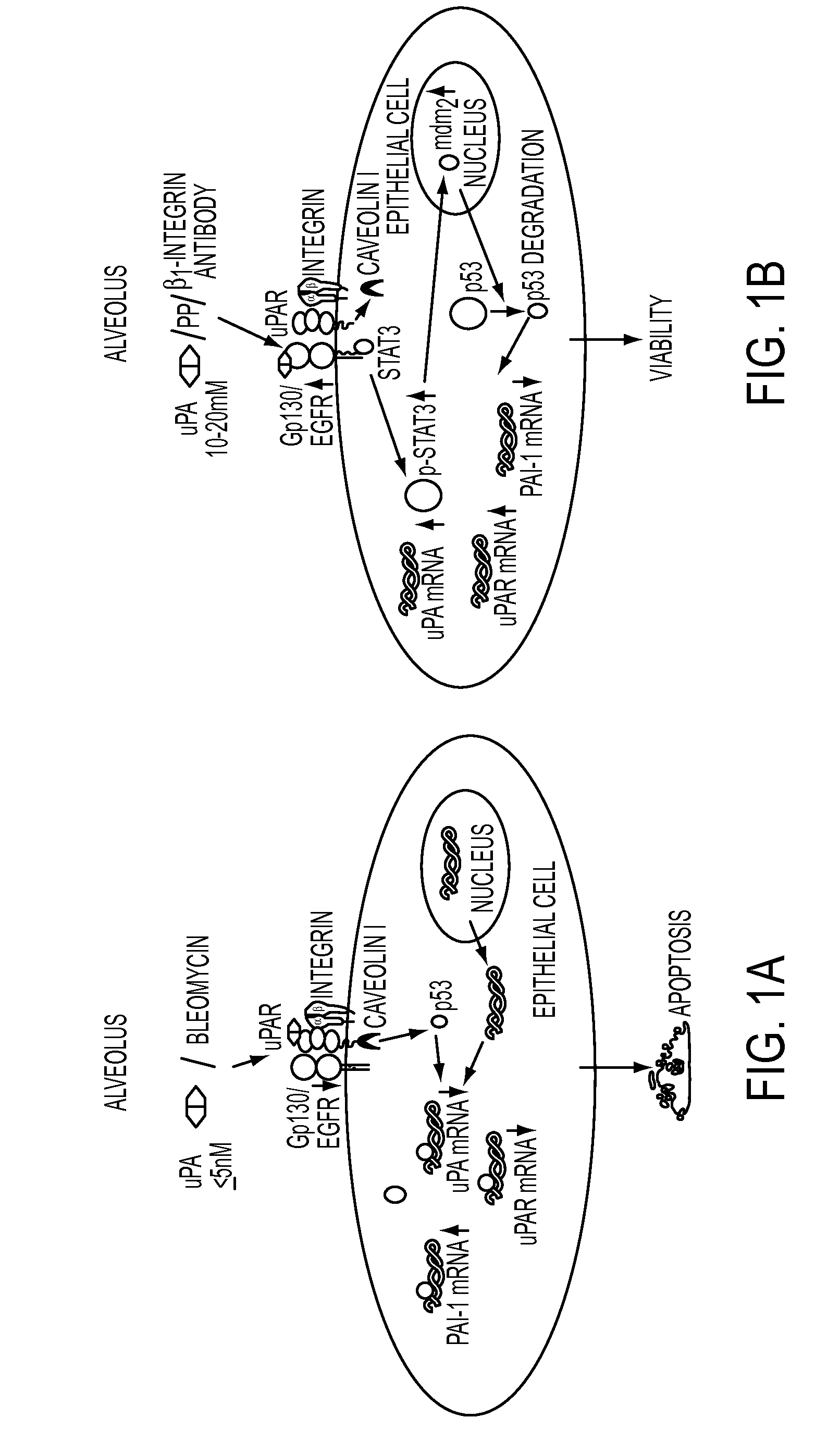Peptide inhibition of lung epithelial apoptosis and pulmonary fibrosis
a technology of pulmonary fibrosis and apoptosis, which is applied in the field of biochemistry and medicine, can solve the problems of affecting the pathogenesis of lung injury and pulmonary fibrosis, limiting the understanding of the regulatory interactions of these molecules, and affecting the survival of lung cells, so as to enhance the expression of pro-survival (or anti-apoptotic) molecules, block bleo-induced mouse lung fibrosis, and improve the effect of l
- Summary
- Abstract
- Description
- Claims
- Application Information
AI Technical Summary
Benefits of technology
Problems solved by technology
Method used
Image
Examples
example i
uPA Induces Dose-Related Apoptosis and Proliferation of Lung Epithelial Cells
[0234]uPA treatment of primary small airway epithelial (SAE) cells in vitro for 48 hours induced apoptosis with an inverted U-shaped dose-response curve over a range of 0.5-20 nM. Cell proliferation is also induced by concentrations of between 5 and 20 nM. The apoptotic effects were weaker than those of bleomycin which did not induced, but rather inhibited cell proliferation. These results appear in FIGS. 2A-2B.
[0235]Western blots were made of extracts of uPA treated cells obtained 24 hours after the uPA was added. Results in FIG. 3 show that both uPA and uPAR expression was induced whereas PAI-1 and p53 expression was suppressed.
example ii
The Effect of Bleo on LEC uPA, uPAR, PAI-1 and p53 Expression In Vitro
[0236]Beas2B cells were treated for 28 h with PBS or 40 μg / ml of bleo in the presence or absence of uPA or its ATF (20 nM), anti-β1-integrin monoclonal antibody (B1), (which activates β1-integrin by clustering), mouse IgG (mIgG), uPA+B1, uPA+mIgG, PP-1 (10 nM), or scrambled control peptide CP-1 (10 nM) at 37° C. In the case of uPA and PAI-1, the full length uPA was substituted with ATF, because uPA-mediated autoinduction or induction of PAI-1 occurs via the interaction of the ATF with uPAR (3-4). The cell lysates (CL) were analyzed for uPA, PAI-1, p53 and β-actin expression by Western blotting using specific antibodies. The membrane proteins were subjected to Western blotting using anti-uPAR antibody. The same responses of PAI-1 and uPA were seen in the conditioned medium (CM) by Western blotting (not shown). Alternatively, immunoprecipitation of cells labeled with 35S-methionine showed the same patterns of protei...
example iii
Induction or Suppression of Lung or BAL Protein Expression by Bleomycin and Effects of PP-1
[0238]Mice were treated intranasally with 50 μl saline or an equal volume of a 40 μg bleomycin solution. After 24 h, 10 mM PP-1 or the same concentration of control peptide CP-1 were given intraperitoneally using a 0.1 ml osmotic pump. Lungs were excised on day 7.
[0239]Lung tissue was chopped into small pieces with fine scissors and rinsed 3× with PBS. The tissues were then homogenized in 1 ml of extraction buffer (25 mM Tris-HCl, pH 7.9. 0.5 mM EDTA and 0.1 mM PMSF) and the homogenate was centrifuged at 12,000 g for 15 min at 4° C. The supernatant was removed and referred to as the crude extract. Protein content was measured using a BioRad protein assay kit. Cytosolic proteins were separated by SDS-PAGE and transferred to a nitrocellulose membrane which was blocked with 1% BSA in a wash buffer for 1 h at room temperature followed by overnight incubation with antibodies specific for uPA, PAI-1...
PUM
| Property | Measurement | Unit |
|---|---|---|
| molecular weight | aaaaa | aaaaa |
| time | aaaaa | aaaaa |
| volume | aaaaa | aaaaa |
Abstract
Description
Claims
Application Information
 Login to View More
Login to View More - R&D
- Intellectual Property
- Life Sciences
- Materials
- Tech Scout
- Unparalleled Data Quality
- Higher Quality Content
- 60% Fewer Hallucinations
Browse by: Latest US Patents, China's latest patents, Technical Efficacy Thesaurus, Application Domain, Technology Topic, Popular Technical Reports.
© 2025 PatSnap. All rights reserved.Legal|Privacy policy|Modern Slavery Act Transparency Statement|Sitemap|About US| Contact US: help@patsnap.com



